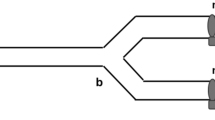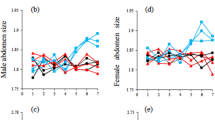Abstract
Female choice for mates with ‘good genes’ presupposes that some males have better genes than others1. However, the resulting selection against inferior males causes such genetic variability to disappear. This paradox may be resolved when substantial variability is maintained at a balance between selection and mutation2. Alternatively, populations may exhibit genetic polymorphisms maintained by frequency-dependent selection or hybrid vigour3,4,5,6,7,8,9. Here we show that a local population of soil predatory mites exhibits genetic variation in preference for two prey species. We find that hybrids between selected preference lines are superior or inferior in population growth rate, depending on the composition of the diet. Finally, we show that females in this population mate disassortatively when hybrids are superior, but switch to assortative mating otherwise. Thus, mate choice varies with diet and is tuned to incorporate ‘good genes’ in the offspring, that is, genes that promote the population growth rate of the offspring on the same diet as that experienced by the parents. In this way, hybrid success and mate choice act together in maintaining or eliminating genetic polymorphism in local populations.
This is a preview of subscription content, access via your institution
Access options
Subscribe to this journal
Receive 51 print issues and online access
$199.00 per year
only $3.90 per issue
Buy this article
- Purchase on Springer Link
- Instant access to full article PDF
Prices may be subject to local taxes which are calculated during checkout


Similar content being viewed by others
References
Andersson,M. Sexual Selection (Princeton Univ. Press, NJ, 1994).
Bulmer,M. G. Maintenance of genetic variability by mutation–selection balance. Genome 31, 761–767 (1989).
Falconer,D. S. & McKay,R. Introduction to Quantitative Genetics 3rd edn (Longman, New York, 1996).
Felsenstein,J. Skepticism towards Santa Rosalia, or why there are so few kinds of animals. Evolution 35, 124–138 (1981).
Hoekstra,R. F., Bijlsma,R. & Dolman,A. J. Polymorphism from environmental heterogeneity: Models are only robust if the heterozygote is close in fitness to the favoured homozygote in each environment. Genet. Res. 45, 299–314 (1985).
Garcia-Dorado,A. The effect of niche preference on polymorphism protection in a heterogeneous environment. Evolution 40, 936–945 (1986).
Meeus, T. de, Michalakis,Y., Renaud,F. & Olivieri,I. Polymorphism in heterogeneous environments, evolution of habitat selection and sympatric speciation: soft and hard selection models. Evol. Ecol. 7, 175–198 (1993).
Jones,J. S. Can genes choose habitats? Nature 286, 757–758 (1980).
Brown,J. L. A theory of mate choice based on heterozygosity Behav. Ecol. 8, 60–65 (1997).
Sabelis,M. W. in Natural Enemies, The Population Biology of Predators, Parasites and Diseases (ed. Crawley, M. J.) 225–264 (Blackwell Scientific, Oxford, 1992).
Lesna,I., Sabelis,M. W. & Conijn,C. G. M. Biological control of the bulk mite, Rhizoglyphus robini, by the predatory mite, Hypoaspis aculeifer, on lilies: Predator–prey interactions at various spatial scales. J. Appl. Ecol. 33, 369–376 (1996).
Lesna,I. Bulb mite biocontrol: evolutionary genetics of prey choice in soil predators. Ph.D. Thesis, Univ. Amsterdam (1998).
Witalinski,W. Sperm competition in the Acari. Exp. Appl. Acarol. 23, 455–465 (1999).
Maynard Smith,J. Sympatric speciation. Am. Nat. 100, 637–650 (1966).
Futuyma,D. J. & Moreno,G. The evolution of ecological specialization. Annu. Rev. Ecol. Syst. 19, 207–233 (1988).
Chesson,P. L. in Community Ecology (eds Diamond, J. & Case, T. J.) 240–254 (Harper and Row, New York, 1986).
Chesson,P. A need for niches? Trends Ecol. Evol. 6, 26–28 (1991).
Serradilla,J. M. & Ayala,F. J. Alloprocoptic selection: A mode of natural selection promoting polymorphism. Proc. Natl Acad. Sci. USA 80, 2022–2025 (1983).
Gilburn,A. A. & Day,T. H. Evolution of female choice in seaweed flies: Fisherian and good genes mechanisms operate in different populations. Proc. R. Soc. Lond. B 255, 159–165 (1994).
Houtman,A. M. & Falls,J. B. Negative assortative mating in the white-throated sparrow: the effect of mate choice and intrasexual competition. Anim. Behav. 48, 377–383 (1994).
Lenington,S. The t-complex: a story of genes, behavior, and populations. Adv. Study Behav. 20, 51–86 (1991).
Coopersmith,C. B. & Lenington,S. Preferences of female mice for males whose t-haplotype differs from their own. Anim. Behav. 40, 1179–1181 (1990).
Lenington,S., Coopersmith,C. B. & Erhart,M. Female preference and variability among t-haplotypes in wild house mice. Am. Nat. 144, 766–784 (1994).
Potts,W. K., Manning,C. J. & Wakeland,E. K. The role of infectious disease, inbreeding and mating preferences in maintaining MHC genetic diversity: an experimental test. Phil. Trans. R. Soc. Lond. B 346, 369–378 (1994).
Penn,D. J. & Potts,W. K. The evolution of mating preferences and major histocompatibility complex genes. Am. Nat. 153, 145–164 (1999).
Penn,D. J. & Potts,W. K. MHC-disassortative mating preferences reversed by cross-fostering. Proc. R. Soc. Lond. B 265, 1299–1306 (1998).
Edwards,S. V. & Hedrick,P. W. Evolution and ecology of MHC molecules: from genomics to sexual selection. Trends Ecol. Evol. 13, 305–311 (1998).
Sokal,R. R. & Rohlf,F. J. Biometry (Freeman, New York, 1995).
Acknowledgements
We thank M. Boerlijst, H. Breeuwer, S. Elliot, A. Janssen, R. Lingeman, Y. Michalakis, N. van Straalen, F. Vala and A. Weeks for discussion and comments on the manuscript. This work was funded by the Technology Foundation (S.TW) and the Netherlands Organization of Scientific Research (NWO).
Author information
Authors and Affiliations
Corresponding author
Rights and permissions
About this article
Cite this article
Lesna, I., Sabelis, M. Diet-dependent female choice for males with ‘good genes’ in a soil predatory mite. Nature 401, 581–584 (1999). https://doi.org/10.1038/44125
Received:
Accepted:
Issue Date:
DOI: https://doi.org/10.1038/44125
This article is cited by
-
Small-scale genetic structure of populations of the bulb mite Rhizoglyphus robini
Experimental and Applied Acarology (2023)
-
Prey preference and life tables of the predatory mite Parasitus bituberosus (Acari: Parasitidae) when offered various prey combinations
Experimental and Applied Acarology (2013)
-
Sexual selection and the evolution of evolvability
Heredity (2007)
-
Variation in polyandry and its fitness consequences among populations of the red flour beetle, Tribolium castaneum
Evolutionary Ecology (2007)
-
Male sexual attractiveness affects the investment of maternal resources into the eggs in peafowl (Pavo cristatus)
Behavioral Ecology and Sociobiology (2007)
Comments
By submitting a comment you agree to abide by our Terms and Community Guidelines. If you find something abusive or that does not comply with our terms or guidelines please flag it as inappropriate.



